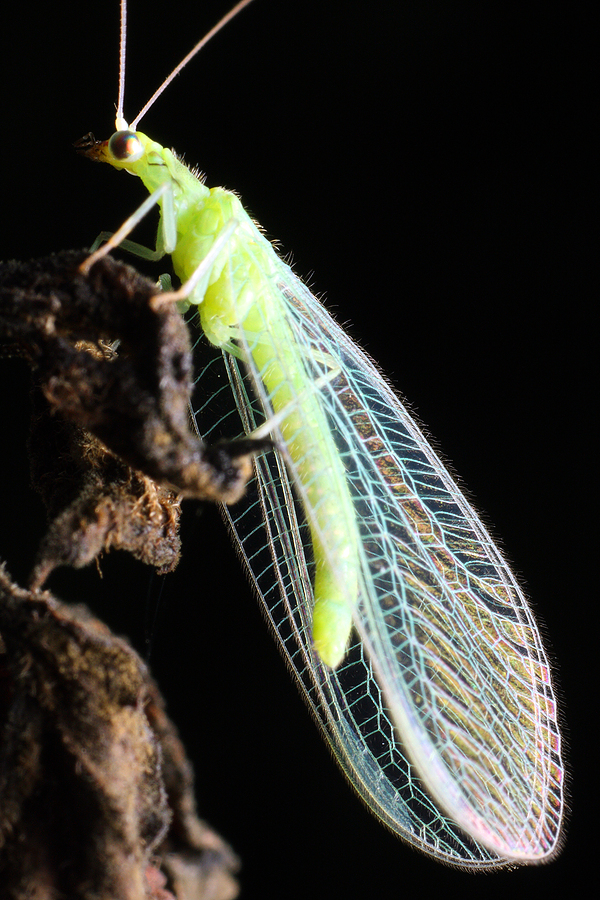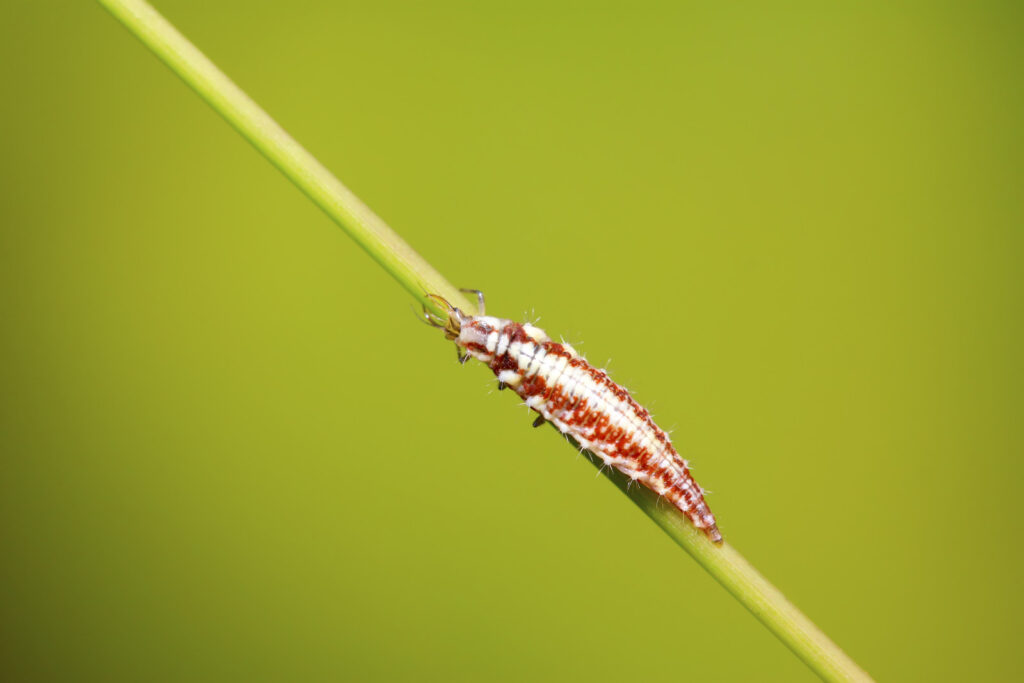Green lacewings are beneficial insects.
Adult lacewings feed on nectar, pollen, and aphid honeydew. Young, larvae lacewings feed on the eggs and immature stages of many soft-bodied insect pests including aphids, asparagus beetle larvae, caterpillar eggs and young caterpillars, Colorado potato beetle larvae, spider mites, thrips, whiteflies, leafhoppers, and the eggs of pest moths and mealybugs.
One lacewing larva—also known as an aphid lion—can devour 100 aphids in a week. One or two or three larva in each square foot of a garden can rid the garden of almost all soft-bodied pests in two to three weeks. Larvae grasp their prey with their mandibles and disable them by injecting them with a toxic digestive secretion before eating them. They are voracious predators. Lacewing larvae are sometimes called “aphid lions.”

Various species of green lacewings are found throughout North America and Europe.
The scientific name of the green lacewing is Chrysopa spp., Chrysoperla spp.; of the family Chrysopidae.
Good Products for Pest and Disease Control at Amazon:
- Garden Safe Snail and Slug Bait
- Bonide Sulfur Fungicide
- Monterey BT Caterpillar Killer
- Neem Bliss 100-% Cold Pressed Neem Oil
- Safer Brand Insect Killing Soap
- PyGanic Botanical Insecticide
How to identify the green lacewing
Adult green lacewing
The adult green lacewing has delicate features: a bright green to pale green to greenish-brown smooth body, and four, transparent and slightly iridescence wings with a fine network of visible veins. The delicate long green wings are ½ to ¾ inch long (6 to 65 mm). The lacewing has knobbed antennae, and many species have golden eyes. Adults have chewing mouth parts. The adult lacewing is sometimes called a stink fly because it can emit an unpleasant odor when handled. An adult lacewing lives for 4 to 6 weeks; a female can lay as many as 1,000 eggs before dying. Adults are nocturnal flying about during the cool of the evening and early morning hours; they are attracted to bright lights.
Green lacewing larva
The green lacewing larva or nymph is yellowish gray with brown marks, tufts of hair, and a long jaw with curved mandibles that pinch together; it looks a bit like a tiny alligator. The larva grows to about 3/8 inch long. The larva is a voracious predator attacking soft-bodied insects such as aphids and caterpillars of like or smaller size. The larva uses its maxillae to seize and pierce prey and inject paralyzing venom; it then sucks body fluids from its prey. The larva can suck the life juice from an aphid in 90 seconds and can eat 100 aphids or more in a week. A larva develops over two to three weeks then pupates by spinning a silky white cocoon; an adult emerges five days later. and four to six weeks and repeat the life cycle.
Green lacewing eggs
Green lacewing eggs are oblong and white or green. Eggs are laid singly attached to the underside of leaves by a threadlike filament. Eggs are often laid on the leaves of plants infested with aphids. Eggs are deposited at night and hatch within a few days. The filament keeps emerging young larvae from eating each other after they hatch. The tiny predatory larvae begin eating soft-bodied insects such as aphids immediately. The larvae are known as aphid lions eating 100 aphids or more before they pupate. Larvae or nymphs live 15 to 20 days before pupating.
Green lacewing life cycle
Adult lacewings lives 4 to 6 weeks. Female lacewings lay eggs singly or in small groups. Eggs are placed on plants usually where aphids are nearby. Each egg is hung on a slender stalk on the underside of a leaf. Immediately after hatching, the larvae ascend the egg stalk to feed.
Females lacewings lay eggs; the eggs hatch within 3 to 4 days; A larva develops over 2 to 3 weeks, then puates spinning a cocoon; An adult emerges from the cocoon five days later.
There can be three to four generations or more of lacewings in a growing season depending upon the length of the warm temperature season. They emerge from cocoons and begin adult life when the air temperature ranges between 65°F and upper 80s. Lacewings pass the winter in the pupal stage, cocoons. All stages of lacewings can survive mild winters.

Green lacewing feeding habits
Adult lacewings feed on pollen, nectar, and honeydew (the excrement of aphids and other sucking insects). Many adults also prey on aphids, various larvae, and the eggs of other insects. Lacewing larvae feed an aphids, young corn earworms, mites, young scale insects, whiteflies, leafhoppers, thrips, and eggs of most caterpillars, and other small pests. Lacewings do most of their hunting at end of the larval stage.
How to attract green lacewings to the garden
Attract lacewings to the garden by planting plants rich in pollen and nectar such as angelica, caraway, coreopsis, cosmos, goldenrod, marguerite daisies, Queen Anne’s lace, tansy, and yarrow. Lacewings eat pollen and nectar in addition to insect pests.
Lacewings can be attracted to a garden by nectar producing flowers such as Queen Anne’s lace, coreopsis, cosmos, sunflowers, dill, and angelica. Lacewings are also attracted by a yeast-sugar water mix called Wheast. Green lacewings are commercially available and among the most commonly released predators or beneficial insects.
Adult lacewings feed on the pollen and nectar of wild carrot, Queen Anne’s lace, Queen Anne’s lace, coreopsis, cosmos, sunflowers, dill, angelica, and oleander. Adult lacewings are also attracted to an artificial diet called Wheast, one part sugar and one part brewer’s yeast in water. Use host plants or Wheast to attract and keep lacewings in the garden.
How to control pest insects with green lacewings
You will need 1,000 green lacewings to cover a garden of 1,000 square feet. Lacewings are commercially available and are commonly shipped as eggs. Place 1 to 3 eggs on each plant; not more densely or the larvae will eat each other. Eggs should be lodged gently in the crevices of leaves or flower petals or sprinkle the larvae around the garden. Release new lacewings every 10 to 15 days.
Related articles:
Vegetable Garden Beneficial Insects
Vegetable Garden Organic Pest Control
Vegetable Garden Diseases Problem Solver
Vegetable Garden Organic Weed Control
Garden Planning Books at Amazon:
- Vegetable Garden Almanac & Planner
- Kitchen Garden Grower’s Guide Vegetable Encyclopedia
- Vegetable Garden Grower’s Guide
- Tomato Grower’s Answer Book















